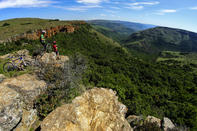The Biggest Challenge
From Waterval Onder, the road ascends steeply up the slopes of the Elandsberg and about 2 km before reaching Waterval Boven, passes the old Nederlandsch Zuid-Afrikaansche Spoorweg Maatschappij tunnel.

In the early 1890s, the steep gradient of the Escarpment presented the biggest challenge to the engineers tasked with building the railway line between Pretoria and the Mozambican port of Lourenço Marques (Maputo) to provide the ZAR with an independent outlet to the sea.
To reduce the gradient, a tunnel of about 400 m was built through the Elandsberg. Drilling started from both ends in October 1892 and the two teams met in September the following year. A view site near the entrance of the tunnel provides a fine view over the 90-m-high Elands River Falls.
This section of the railway line also incorporated more than 3 km of rack railway to assist the locomotives. The rack railway incorporated a middle rail fitted with a rack that engaged a pinion on the locomotive to provide extra traction.
A 32-ton rack engine, capable of hauling 140 tons, was coupled behind the train to push it at a speed of 8 kph; part of the original rack system can be seen at the Waterval Boven Station. Also of interest at the station is one of the original locomotives used on this route and a monument commemorating the construction of the line.